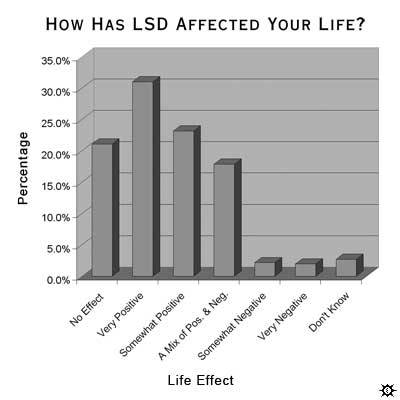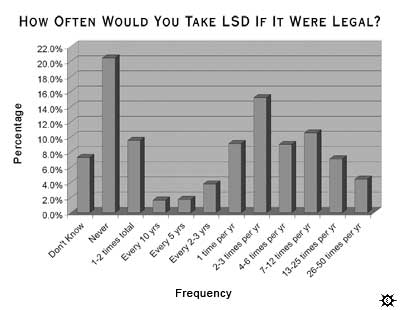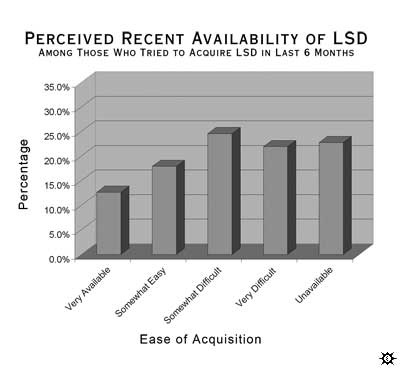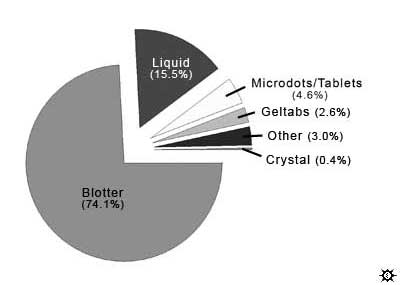Erowid Visitors on LSD
The Results of Eight LSD-Related Surveys
Conducted on Erowid Between Oct 2005 and Jan 2006
Conducted on Erowid Between Oct 2005 and Jan 2006
Jun 2006
Citation: Erowid F, Erowid E. "Erowid Visitors on LSD". Erowid Extracts. Jun 2006;10:10-12.
"LSD made me take a whole different perspective on everyday life and gave me a more positive outlook on the future."
Previous Surveys on Erowid
Over the last few years, Erowid has conducted a number of online surveys about the use of psychoactive plants and chemicals. Our first major survey concerned the use of psilocybin mushrooms and other psychedelics in treating severe migraine-like headaches called "cluster headaches". This ongoing survey has been running for more than three years and has received over 200 promising responses--a respectable number, given the rarity of both the condition and the small likelihood that sufferers would have tried psychedelics as a treatment. This survey has helped lead to more formal research, including a soon-to-be published summary of the survey findings and follow-up contact with survey respondents by Dr. Andrew Sewell of Harvard Medical School. In 2002, we conducted a survey about the perception of risk among Ecstasy users, the results of which were published in Drug and Alcohol Dependence.1 The survey refuted often-repeated and unsupported claims in scientific and medical journals that "ecstasy users think the drug is completely safe".
In 2002, we conducted a survey about the perception of risk among Ecstasy users, the results of which were published in Drug and Alcohol Dependence.1 The survey refuted often-repeated and unsupported claims in scientific and medical journals that "ecstasy users think the drug is completely safe".We have also done some interesting survey work with Matthew Baggott, a researcher in San Francisco. One administered two years ago (about which we published an article in the June 2004 issue of Erowid Extracts) examined use of Salvia divinorum. We have also conducted two surveys looking at Hallucinogen Persisting Perceptual Disorder (HPPD), the results of which are pending publication.
Why LSD Surveys?
Our aim was to conduct a series of LSD-related surveys to gather data about current use for the occasion of Albert Hofmann's 100th birthday.In the early days of LSD, many users congregated in relatively isolated small enclaves, with little communication between them. Now, after more than fifty years of LSD use around the world, there is both a massive untapped history surrounding the use of LSD and the technological means (the Internet) to begin collecting it in a rigorous fashion.
One of the major questions that led to the start of Erowid itself was, "What do people who used psychedelics ten, twenty, or thirty years ago think of that use now?" Knowing what individuals from the previous generation of LSD users think about their use could be valuable to those contemplating trying LSD in the future. Do most people regret their use, or was it the best thing that ever happened to them? Do they still use LSD? If not, why not?
While it is difficult to glean details about the earliest users of LSD, we can gather this information from current users and make the information available for future generations. More than ever before, it is possible today to just ask LSD users what they think.

Survey Limitations
As with any survey, there are inherent limitations to the data we collect. Our survey population consists of self-selected Erowid visitors, a very specific sub-set of the world's population. Because people from this group are actively seeking information about psychoactives, they are more likely to use illegal substances than a random sampling of the general population. Survey respondents must also have Internet access, and be able to read English, resulting in under-representation of certain demographics. Respondents must also be willing to fill out surveys about illegal substance use, which may preclude the more cautious from participating.We have taken several steps to help improve survey process, such as repeating identical questions on multiple surveys to compare results. We also try, as often as possible, to include options of "Don't know" and "Prefer not to answer". Finally, we identify inconsistent and absurd answers, and exclude those responses from our results.
It is worth noting that a recent article published in Addictive Behaviors by McCabe et al. found that Internet surveys may yield very similar results to mail-in surveys, yet with higher response rates. This suggests, that from a methodological standpoint, online surveys may not be inherently inferior to traditional anonymous survey methods.2
Results
We conducted eight separate LSD-related surveys between October 2005 and January 2006, most of which collected responses for 3-7 days. Six of the eight surveys were "micro-surveys" consisting of 3-4 questions each, displayed at the top of nearly all pages on the Erowid.org website, ensuring a high response rate. Each micro-survey yielded between 3,000 and 6,000 responses per 24-hour period that it was displayed. The other two surveys were identical and longer, attempting to identify trends in current LSD availability. We received a total of 136,057 responses to the eight surveys; 123,459 of these (90.7%) were determined to be valid after the removal of spam, duplicates, and invalid responses.How Many Have Tried LSD?
We asked the same question, "How many times have you taken LSD", in five different surveys spanning the four-month period. Responses were relatively consistent across these five surveys. In micro-surveys, 62.0-64.6% of respondents reported having taken LSD at least once. Compare this to approximately 10% of the U.S. population over the age of 12 that report LSD use when asked as part of the government-sponsored National Household Survey.3
The two longer-format surveys showed higher percentages of respondents who report having taken LSD (70.3-75.8%). One explanation for this is that people who have never taken LSD were less interested in filling out a longer LSD-related survey. This is a small hint at the complications of sampling bias: even in well-controlled surveys, those with strong opinions or a personal history with the subject matter may be more motivated to take the time and energy to participate.

Positive vs. Negative
(9,439 valid responses)
Of all respondents, to this micro-survey, 62.8% reported having taken LSD at least once. Of these, 14.5% report having experienced at least one "very" or "extremely" "bad trip", 20.8% report having had at worst a "mild" or "somewhat" bad trip, and 64.4% report that they have never had a bad trip.On the other hand, 57.7% report having had a "mystical" or "very profound" positive experience, while 28.3% have had at best a "relatively mild" or "somewhat profound" positive experience, and 13.4% have never had what they would consider a "mystical" or "strikingly positive" experience of any kind.
Across all LSD-using respondents, nearly four times as many (57.7%) report having had a "mystical" or "very profound" positive experience than report having had a "very" or "extremely" bad trip (14.5%). Higher total lifetime use was correlated with an increased likelihood of very positive and very negative experiences. Among respondents who had used LSD more than 25 times, 79.4% reported having had at least one "mystical" or "very profound" positive experience while 27.6% reported having had at least one "very" or "extremely" bad trip.
Some of this disparity between reported positive and negative experiences may be due to a loss of interest in psychedelics among people who have had bad experiences; this could result in those individuals being underrepresented in a survey of Erowid visitors. But it is also possible that those who have had the worst experiences with LSD might be the most likely to seek information about it online. Determining this is outside the scope of these surveys.
"LSD has opened up my mind and made me fearless to the unknown."
Effects on Life
(49,039 valid responses)
Of those who have taken LSD, 53.4% said that it has affected their life positively, compared to 3.4% who said it had a negative effect on their life. 21.9% reported that LSD had "no effect" and 17.2% reported a "mix of positive and negative effects".Interestingly, people who have taken LSD 100+ times were the most likely to say that it has "very positively" affected their life (46.9%). An additional 17.4% said LSD has affected their life "somewhat positively", and 21.2% reported a "mix of positive and negative" effects. Also, people who have taken LSD 100 or more times are more likely than any other group to say that their LSD use has affected their life "somewhat negatively" (1.4%) or "very negatively" (2.6%).

This table compares reports of bad reactions to LSD with reports of positive reactions on thhis survey. The two colors of bars are answers to two distinct questions. The dark bars are answers to the question "Have you had a mystical or strikingly positive experience on LSD?" and the white bars are answers to the question "Have you had what you would describe as a 'bad trip' on LSD?".
When answering how long ago they first took LSD, 24.8% of respondents said it was in the past year, compared to those who said 2-5 years ago (34.8%), 6-10 years ago (16.9%), 11-20 years ago (14.6%), and more than 20 years ago (8.9%). We found no consistent trend in correlation between years since first LSD experience and perceived positive or negative effects.
Recent Use
(11,757 valid responses)
We attempted to get a sense of respondent age, in relation to frequency of LSD use, and how long ago they first tried LSD.Results for respondent age were fairly consistent between this and other surveys we have conducted: 20.8% were 10-18 years old, 42.4% 18-22 years old, and 36.8% older than 22.
Overall, 41.6% of respondents reported having taken LSD in the last five years. The longer ago they first tried LSD, the less likely they were to have taken it recently: 55.1% of those who first tried LSD 5-20 years ago had taken it in the last five years, while only 17.1% of those who first took LSD more than 30 years ago also reported having taken it in the last five years.
The 18- to 22-year-old group was the most likely to have taken LSD in the past five years (69.8%) compared to 15- to 17-year-olds (60.0%) and 23- to 29-year-olds (65.7%). A much lower portion (19.5%) of 50- to 59-year-olds reported having used LSD during that period.
"LSD showed me that there is a vastly interesting world that lies just beneath our own, where the mundane can become fantastic and the experiences of the 'day-to-day' can be drastically enhanced. After taking LSD, I felt more in tune with the aesthetics that make life truly incredible."
Does Legal Status Affect Use?
(33,957 valid responses)
One question that is difficult to address is to what extent LSD's legal status affects use levels. Generally, we might expect illegality to disproportionately deter older users, as this population has more to lose by breaking the law and generally would find less peer support for illegal activity. So we asked age, number of times LSD had been taken in the last five years, and, "If LSD were legal, about how often would you take it?"In response to that last question, 20.4% of respondents said "never", while 16.8% said less than once a year, 33.4% said 1-6 times per year, and 22.1% said seven or more times per year.
The frequency with which respondents said they would take LSD if it were legal was inversely proportional to age. Only 13.4% of 18- to 22-year-olds said they would "never" take LSD if it were legal, compared to 49.2% of 60- to 69-year-olds. Of 18- to 22-year-olds, 60.9% said they would take LSD at least once a year if it were legal, compared to 55.6% of those 23-29, 48.3% of those 30-39, 40.8% of those 40-49, 39.2% of those 50-59, and 35.8% of those 60-69.
Context of Use
(16,166 valid responses)
 In order to get a sense of how and where people use LSD, we next asked a series of questions about contexts of LSD use, including, "What was the primary context for your first LSD experience?", "How many people were present in this context?", and "What is your preferred context for taking LSD?".
In order to get a sense of how and where people use LSD, we next asked a series of questions about contexts of LSD use, including, "What was the primary context for your first LSD experience?", "How many people were present in this context?", and "What is your preferred context for taking LSD?".Nearly 75% of all respondents had their first LSD experience in one of the top five location types: at a "friend's house" (27.2%), "home" (20.2%), "outdoors, nature" (14.6%), "wandering in public" (7.7%), or "indoor dance party, rave" (4.9%). A total of 17 different contexts were provided as options. We were pleased that the results were as low as they were for "school or class" (3.0%), and "work or office" (0.4%).
Consistent with the fact that 47.4% of all respondents report having first taken LSD either at a friend's house or at their own home, a setting suitable for small groups of people, 40.8% also report that there were 3-5 people present when they first took LSD. Of the subgroup whose first experience was at a friend's house, 55.1% reported that there were 3-5 people present.
When asked what their preferred context was for LSD experiences, the most frequent answers were "outdoors, nature" (29.9%), "home" (21.6%), and "friend's house" (11.6%).
There was a trend towards respondents preferring the context in which they first took LSD. Of those who first took LSD "outdoors", 58.1% also selected "outdoors" as their preferred context, compared to 29.9% of all respondents or 15.2% of those whose first experience was at an "indoor dance party or rave".
It is unknown whether this correlation stems from people choosing to first use the drug in a context that suits their temperament, or if the first use imprints a preference that is later expressed through subsequent use.
Availability, Quality, & Price
(3,101 valid responses)
 LSD availability has reportedly been low for the last few years. Many people attribute this to the infamous "Kansas silo" LSD bust in the United States in late 2000, but several major LSD manufacturing convictions in the 1990s probably contributed to the reduced availability as well.
LSD availability has reportedly been low for the last few years. Many people attribute this to the infamous "Kansas silo" LSD bust in the United States in late 2000, but several major LSD manufacturing convictions in the 1990s probably contributed to the reduced availability as well.U.S. national surveys show a declining trend in LSD use starting around the same time.4 Between 2000 and 2003, Monitoring the Future showed an unprecedented drop in past-year LSD use by high school seniors (18-year-olds), from 6.6% to 1.9%.
During the same period, the National Household Survey's measure of how many people first try LSD each year dropped from 788,000 to 320,000. Similarly, between 2000 and 2002, DAWN emergency department mentions related to LSD dropped from 4,016 to 891.
To learn more, we conducted two identical longer surveys spaced three months apart (October 2005 and January 2006) with questions focusing on LSD availability. Of those who responded to the two availability surveys, 72.5% reported trying to acquire LSD in the past six months. In both surveys, perceived availability was higher among those who had actually tried to acquire LSD in the last six months than among those who had not. In the more recent survey, 22.7% of those who had recently tried to acquire LSD said it was "available", "somewhat easy", or "very easy" to acquire, compared to 12.1% of those who had not tried buying LSD. Respondents who had attempted to acquire LSD in the last six months were also asked how difficult it had been to find LSD during that period. In the first availability survey, 29.2% replied that they had found LSD "very available" or "somewhat easy" to find, 47.0% said it was "somewhat difficult" or "very difficult" to find, and 23.8% said it was "unavailable". In the second availability survey, 30.6% of respondents said LSD was "very available" or "somewhat easy" to find, 46.6% said it was "somewhat difficult" or "very difficult" to find, and 22.8% said it was "unavailable". These numbers suggest that LSD availability may be increasing, which would be consistent with recent rumors. It will take a number of additional identical surveys to determine whether this is a real trend.
In the second of these surveys, 78.5% of those who had recently acquired LSD reported paying between $5 and $14 per "dose or hit". Only 3.8% paid more than $20 and 8.3% reported paid less than $5 per "hit". Prices remained very consistent in the three months between surveys, with a slight trend towards lower prices.
 |  |
"Blotter" was by far the most common form of LSD purchased (74.1%), followed by "liquid" (15.5%), "microdots/tablets" (4.6%), and "geltabs/windowpane" (2.6%). The second survey showed an increase in availability of LSD in liquid form (+3.5%) and a decrease of microdots/tablets (-2.6%) when compared to the identical October 2005 survey.
Requesting information about the quality of a street drug such as LSD can be problematic, as differentiating between quality/purity and dosage per hit can be nearly impossible. A low dose of LSD may often be reported as "poor quality" when the material may actually be of high quality, just low dosage. Very simply, dosage and quality/purity are largely inseparable when discussing the street use of acid. Therefore, we assume that these two factors are combined in the following answers.
In general, perceived "quality" of street LSD was quite a bit higher than we expected: 38.5% of respondents reported that the material they had recently acquired was of either "very high" or "high" quality, compared to 22.9% that reported the quality was "low", "very low", or "inactive". Another 30.0% said that the quality was "average".
 Perceived quality remained quite consistent over the three-month period between the two surveys. Assigning each response a numerical value of 1-6, with the survey response of "average" set equal to 4.0, the reported quality of LSD rose minutely from an average of 4.13 to 4.15 between surveys.
Perceived quality remained quite consistent over the three-month period between the two surveys. Assigning each response a numerical value of 1-6, with the survey response of "average" set equal to 4.0, the reported quality of LSD rose minutely from an average of 4.13 to 4.15 between surveys.Future Surveys
We were quite happy with the large number of responses we received to this series of surveys as well as the fascinating data that resulted. We hope to continue conducting similar research for a variety of psychoactive plants and chemicals. Future questions could try to determine whether LSD is more or less likely to positively impacted people's lives than other materials such as psilocybin-containing mushrooms or MDMA. Stay tuned for more visitor surveys on Erowid in the future.Note: This article is based on a presentation given at the 2006 LSD Symposium in Basel, Switzerland. Results differ slightly because the final two surveys continued to receive responses after the conference. We also did a more thorough job of removing invalid responses for this article. For more information about these surveys, including the texts of the questions and answers, click here.
References #
- Gamma A, Jerome L, Liechti ME, Sumnall HR. "Is ecstasy perceived to be safe? A critical survey." Drug Alcohol Depend. Feb 14, 2005;77(2):185-193.
- McCabe SE, Couper MP, Cranford JA, Boyd CJ. "Comparison of Web and Mail Surveys for Studying Secondary Consequences Associated with Substance Use: Evidence for Minimal Mode Effects." Addictive Behaviors. 2006;31(1):162-8.
- Substance Abuse and Mental Health Services Administration. 2004 National Survey on Drug Use & Health: National Findings. 2005. Accessed May 18, 2006; http://www.oas.samhsa.gof/nsduh.htm.
- Erowid E, Erowid F. "How Do They Measure Up - Part II: The Problems." Erowid Extracts. Nov 2005;9:16-21.

